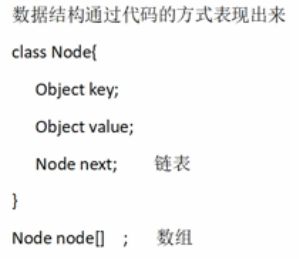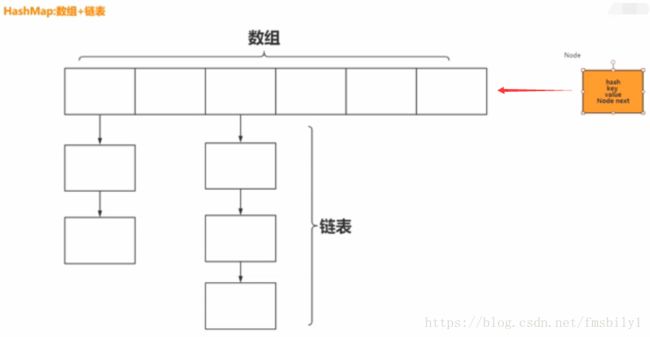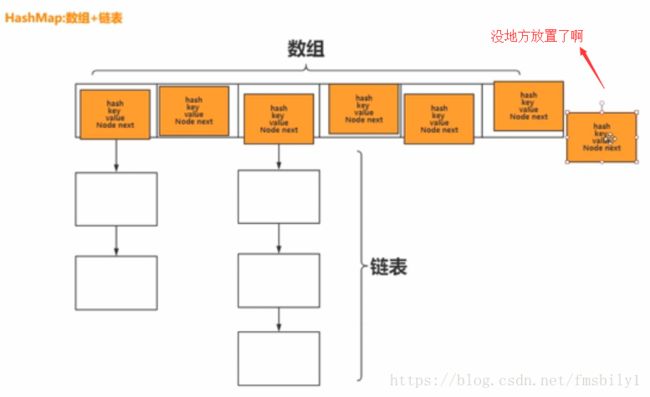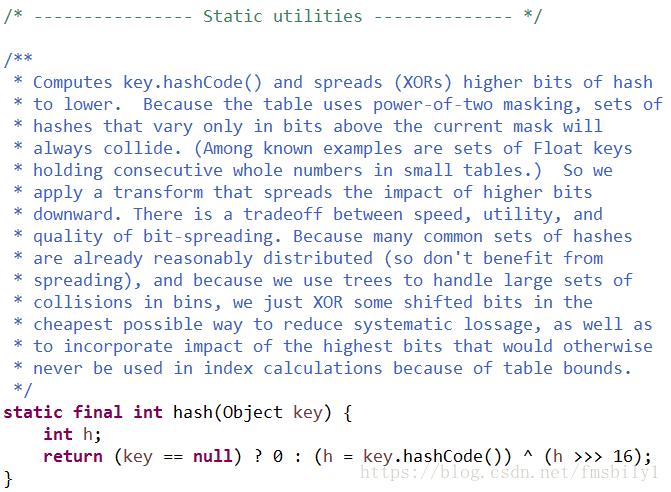java.util包——HashMap类
java.util
类 HashMap
java.lang.Object
java.util.AbstractMap
java.util.HashMap
类型参数:
K - 此映射所维护的键的类型
V - 所映射值的类型
所有已实现的接口:
Serializable, Cloneable, Map
直接已知子类:
LinkedHashMap, PrinterStateReasons
public class HashMap
implements Map
-------------------------------------------------------------------------------------------------------------------------------------------------------------------------
先看几道面试题看看自己掌握多少:
先来段代码:
import java.util.HashMap;
public class HashMapTest {
public static void main(String args[]) {
HashMap hm = new HashMap();
hm.put(1, "jack");
hm.put(2, "tom");
hm.put(3, "vicky");
hm.put(4, "cat");
hm.put(1, "dog");
System.out.println(hm.get(1)); //jack
}
} 这段代码背后隐藏着什么呢?
节点归位,put进去,
这个数组是有大小限制的呀,如果不够的话,我们首先就想到,那就将数组扩大呗,但是,如果我是HashMap的源码的设计者,我不希望,所有节点把数组占满了之后再对它进行扩大,我觉得应该是,就像过日子嘛,节省一点,不能把东西都用光了啊,所以,我们应该要对将来有个打算啊,比如数组默认大小是16,能不能在用到12的时候就进行数组的扩大,这样我们至少是一个会打算的人,哈哈,那么我们可以引入一个<1的小数,比如0.75,数组大小用到16*0.75=12的时候,对数组进行扩大。这个小数的出现就是为了限制我们,不能等到数组全部被占用的时候再去扩大。在HashMap源码里,存在这样的小数:
/**
* The load factor used when none specified in constructor.
*/
static final float DEFAULT_LOAD_FACTOR = 0.75f;
我们称之“加载因子”或“负载因子”。
每个链表的大小也是有限制的,源码里存在这样的变量:
/**
* The bin count threshold for using a tree rather than list for a
* bin. Bins are converted to trees when adding an element to a
* bin with at least this many nodes. The value must be greater
* than 2 and should be at least 8 to mesh with assumptions in
* tree removal about conversion back to plain bins upon
* shrinkage.
*/
static final int TREEIFY_THRESHOLD = 8;
//TREEIFY_THRESHOLD: 上文说过,如果哈希函数不合理,即使扩容也无法减少箱子中链表的长度,因此 Java 的处理方案是当链表太长时,转换成红黑树。这个值表示当某个箱子中,链表长度大于 8 时,有可能会转化成树。
-------------------------------------------------------------------------------------------------------------------------------------------------------------------------
回到我们的代码我们put一个Node节点的时候,到底是放在整个数据结构的哪里呢?
HashMap里的put()方法:
public V put(K key, V value) {
return putVal(hash(key), key, value, false, true);
}
Node节点何去何从?应该有套规则:
hash(key) // hash函数
来一个Node,算出一个值——大小16 肯定将该节点放到0~15之间的值的位置
我们想获取一个整数,想到Object.hashCode()会获得到一个整数,但是这个整数往往很大的,如![]() 。能不能把整数优化呢,我们要把它缩小,我们要取0~15之间的数:
。能不能把整数优化呢,我们要把它缩小,我们要取0~15之间的数:
拿一个整数num%16------取余数(取模),我们肯定知道这个余数肯定在0~15之间的。
我们看源码里hash(key)函数的实现:
static final int hash(Object key) {
int h;
return (key == null) ? 0 : (h = key.hashCode()) ^ (h >>> 16);
}
假设这里hash(key)计算会得到3254239,
真正计算这个Node节点在数组的什么位置:
实际上,这里的(n-1) & hash ============> hash%n 两种方式都能得到0~15之间的数值
因为,得到的hash值3254239,转化为计算机可识别的二进制1100011010011111011111,而n-1呢,n是数组大小,
默认大小是16,用二进制表示10000,n-1是15,二进制表示01111,01111&1100011010011111011111
000000000000000001111 (15) &
1100011010011111011111(3254239)
最终得到的结果,最大不过是15而已。
这里为什么不用取模操作?当然是因为&与操作在计算机里速度快,即效率高。
-------------------------------------------------------------------------------------------------------------------------------------------------------------------------
问题来了,这里数组默认16(10000),n-1是15(01111),那么假设我们默认大小是15,n-1是14(01110),那么,
000000000000000001110(14) &
1100011010011111011111(3254239)
二者做&操作的时候,结果是000000000000000001110,这样会存在问题。(自己想吧)
只有当是000000000000001111(后面全是1)这样的时候 & 通过hashcode获取到的hash值,得到的结果才真正取决于hash(key)计算出来的结果(即真正取决于我们本身的key,计算得出来的值,来得到该节点所在数据结构的位置,而不是受我们数组大小的影响),所以,我们要保证数组大小是这样的0~15,0~31,0~63......即数组大小是2的n次幂(2^n)。
所以,我们看到HashMap源码里这样初始化数组:
/**
* The default initial capacity - MUST be a power of two.
*/
static final int DEFAULT_INITIAL_CAPACITY = 1 << 4; // aka 16
/**
* The maximum capacity, used if a higher value is implicitly specified
* by either of the constructors with arguments.
* MUST be a power of two <= 1<<30.
*/
static final int MAXIMUM_CAPACITY = 1 << 30;
只有数组大小是2^n的时候,在后面和hash(key)的值做&操作的时候,结果才会真正取决于key。
-------------------------------------------------------------------------------------------------------------------------------------------------------------------------
hash函数的实现里,我们发现,它并不满足通过key给我们带来的hashcode值,实现里面将我们获取到key的hashcode值3254239(1100011010011111011111)向右移了16位,:
0000000000110001 1010011111011111 (低16位) ------3254239
0000000000000000 0000000000110001(高16位) 1010011111011111(移出)
二者进行异或(^)操作,不满足的原因是什么呢?为什么还要这样折腾?
我们每次算出的key.hashcode()的值,比如key1.hashcode(),key2.hashcode()转化为二进制数之后,它们的低级位重复率比较大,结果一旦重复之后,得到的位置可能是一样的,比如都是2,那么重复的就会放到相应的下面链表里,导致链表会越来越长,链表长到一定程度的时候,这时候就会导致链表转换为红黑树,链表转红黑树非常损耗性能,所以,尽量还是使用原来这种数组+链表的方式,我们尽量让Node节点分散一点。让通过key计算出来的位置值尽可能不一样,每一个在允许范围内的位置尽可能的利用起来,此时的HashMap的利用率才是最高的。归根结底,要保证计算出来的每个key的,key.hashcode()的低级位置不让其重复,那么就通过低16位^高16位(至于为什么这样,此处未完待续),将key.hashcode()的低16位和高16位充分利用起来,这样才会使数组的利用率大大增加。
-------------------------------------------------------------------------------------------------------------------------------------------------------------------------
回顾,为什么HashMap源码的Node节点类里有hash这么样一个属性呢?
Java是一门面向对象的语言,自己的Node节点要去哪儿,自己最清楚,自己来维护。
下面我们就开始正式put:
/**
* The table, initialized on first use, and resized as
* necessary. When allocated, length is always a power of two.
* (We also tolerate length zero in some operations to allow
* bootstrapping mechanics that are currently not needed.)
*/
transient Node[] table; /**
* Implements Map.put and related methods
*
* @param hash hash for key
* @param key the key
* @param value the value to put
* @param onlyIfAbsent if true, don't change existing value
* @param evict if false, the table is in creation mode.
* @return previous value, or null if none
*/
final V putVal(int hash, K key, V value, boolean onlyIfAbsent,
boolean evict) {
Node[] tab; Node p; int n, i;
if ((tab = table) == null || (n = tab.length) == 0)
//对数组进行初始化调用resize()
n = (tab = resize()).length;
//判断某位置是否为空,若为空,就在创建节点并赋值给该tab[i]
if ((p = tab[i = (n - 1) & hash]) == null)
tab[i] = newNode(hash, key, value, null);
//数组的某位置不为空,就会走下面的链表
else {
Node e; K k;
//待存储在该位置的的Node节点的hash和key和在该位置上的节点的hash和key是否相同
if (p.hash == hash &&
((k = p.key) == key || (key != null && key.equals(k))))
//相同,则覆盖该位置上的原节点
e = p;
//hash和key不相同,判断p节点是不是TreeNode
else if (p instanceof TreeNode)
e = ((TreeNode)p).putTreeVal(this, tab, hash, key, value);
//既不是对原来的值进行覆盖,也不是红黑树,就来到了链表结构
else {
//对链表进行循环,找到p.next为空的节点,将节点放到这个位置
for (int binCount = 0; ; ++binCount) {
if ((e = p.next) == null) {
p.next = newNode(hash, key, value, null);
//某条链表加了一个节点之后,判断链表的长度,太长的话将链表会转红黑树
if (binCount >= TREEIFY_THRESHOLD - 1) // -1 for 1st
treeifyBin(tab, hash); //转红黑树
break;
}
if (e.hash == hash &&
((k = e.key) == key || (key != null && key.equals(k))))
break;
p = e;
}
}
//如果某位置有值的话,要对其进行覆盖时,要将老值进行返回,例如,
/**hm.put(1, "dog");
hm.put(1, "cat");
hm.get(1)结果返回的是dog
*/
if (e != null) { // existing mapping for key
V oldValue = e.value;
if (!onlyIfAbsent || oldValue == null)
e.value = value;
afterNodeAccess(e);
return oldValue;
}
}
++modCount;
//如果数组占用的数量>16*0.75,我们就resize()操作来扩容,
//所以resize()不仅初始化数组;还有个功能就是对数组进行扩容。
if (++size > threshold)
resize();
afterNodeInsertion(evict);
return null;
} if ((tab = table) == null || (n = tab.length) == 0)
n = (tab = resize()).length;初始化数组
/**
* Initializes or doubles table size. If null, allocates in
* accord with initial capacity target held in field threshold.
* Otherwise, because we are using power-of-two expansion, the
* elements from each bin must either stay at same index, or move
* with a power of two offset in the new table.
*
* @return the table
*/
final Node[] resize() {
Node[] oldTab = table;
int oldCap = (oldTab == null) ? 0 : oldTab.length;
int oldThr = threshold;
int newCap, newThr = 0;
if (oldCap > 0) {
if (oldCap >= MAXIMUM_CAPACITY) {
threshold = Integer.MAX_VALUE;
return oldTab;
}
//对数组进行扩容的操作,例如10000<<1,就变成100000,即由16变成32;
//同时,16*0.75也要进行扩容变成32*0.75;
else if ((newCap = oldCap << 1) < MAXIMUM_CAPACITY &&
oldCap >= DEFAULT_INITIAL_CAPACITY)
newThr = oldThr << 1; // double threshold
}
else if (oldThr > 0) // initial capacity was placed in threshold
newCap = oldThr;
else { // zero initial threshold signifies using defaults
newCap = DEFAULT_INITIAL_CAPACITY;
newThr = (int)(DEFAULT_LOAD_FACTOR * DEFAULT_INITIAL_CAPACITY);
}
if (newThr == 0) {
float ft = (float)newCap * loadFactor;
newThr = (newCap < MAXIMUM_CAPACITY && ft < (float)MAXIMUM_CAPACITY ?
(int)ft : Integer.MAX_VALUE);
}
threshold = newThr;
@SuppressWarnings({"rawtypes","unchecked"})
Node[] newTab = (Node[])new Node[newCap];
table = newTab;
/**以下判断的原因是什么呢,扩容之后你要用人家呀,这样扩容才有意义啊,
*将新扩容的数组用起来,也就是将原有的节点往新的扩容的数组进行迁移的一个过程,
*怎么迁移,原来是数组,是链表,是红黑树的节点各自怎么迁移。
*/
if (oldTab != null) {
for (int j = 0; j < oldCap; ++j) {
Node e;
//数组j位置是否为空,不为空
if ((e = oldTab[j]) != null) {
//置空
oldTab[j] = null;
//数组该位置下面没有任何,将该节点放到扩容数组里去
if (e.next == null)
newTab[e.hash & (newCap - 1)] = e;
//如果该数组节点属于TreeNode节点,将红黑树打散放入新的数组,具体看split方法
else if (e instanceof TreeNode)
((TreeNode)e).split(this, newTab, j, oldCap);
//如果该数组位置下是链表,对链表进行循环遍历
else { // preserve order
Node loHead = null, loTail = null; //原头,原尾
Node hiHead = null, hiTail = null; //新头,新尾
Node next;
do {
next = e.next;
/**
oldCap是16(10000),和e.hash做&操作,判断结果是否为0
0000000000000000 0000000000010000
0100100010000010 0001010010110100
要想结果为0,那么hash值的第五位必须为0,
*/
if ((e.hash & oldCap) == 0) {
if (loTail == null)
loHead = e;
else
loTail.next = e;
loTail = e;
}
else {
if (hiTail == null)
hiHead = e;
else
hiTail.next = e;
hiTail = e;
}
} while ((e = next) != null);
if (loTail != null) {
loTail.next = null;
newTab[j] = loHead;
}
//链表里的节点何去何从:如果链表处的某节点,不为空
if (hiTail != null) {
hiTail.next = null;
//加上oldCap,即加上原来容量的位移,这里也就是指16
newTab[j + oldCap] = hiHead;
}
}
}
}
}
return newTab;
} oldCap=0,执行下面这句,这句就属于对数组进行初始化:
else { // zero initial threshold signifies using defaults
newCap = DEFAULT_INITIAL_CAPACITY; //相当于16
newThr = (int)(DEFAULT_LOAD_FACTOR * DEFAULT_INITIAL_CAPACITY); //相当于16*0.75
}newThr12这个值的作用是为了告诉数组,数组大小用到了12,要进行一个扩容操作。
然后,将newThr赋值给threshold:threshold是一个全局变量int threshold;,为了记录16*0.75这样的一个值
threshold = newThr;
-------------------------------------------------------------------------------------------------------------------------------------------------------------------------
要记录数组用了多少,这里指的是到底有没有超过12:
/**
* The number of key-value mappings contained in this map.
* 包含在该映射中的键值映射的数目,这里应该指的是数组占用了多少
*/
transient int size;-------------------------------------------------------------------------------------------------------------------------------------------------------------------------
双倍扩容,看上面的注释......







